HZ 2: Comprehensive Report on Shingles: Epidemiology, Risk Analysis
VerifiedAdded on 2022/08/09
|6
|1040
|433
Report
AI Summary
This report provides a comprehensive overview of shingles, also known as herpes zoster, focusing on its epidemiology and risk factors. It examines the incidence rates in Saudi Arabia and worldwide, highlighting the prevalence of the viral infection and its impact on different populations. The report details the risk analysis, including factors such as age, stress, weakened immune systems, and underlying health conditions. It also includes mortality rates and hospital admission statistics, offering a detailed understanding of the health issue. By analyzing these factors, the report aims to provide insights into the global burden of shingles and its implications for public health.
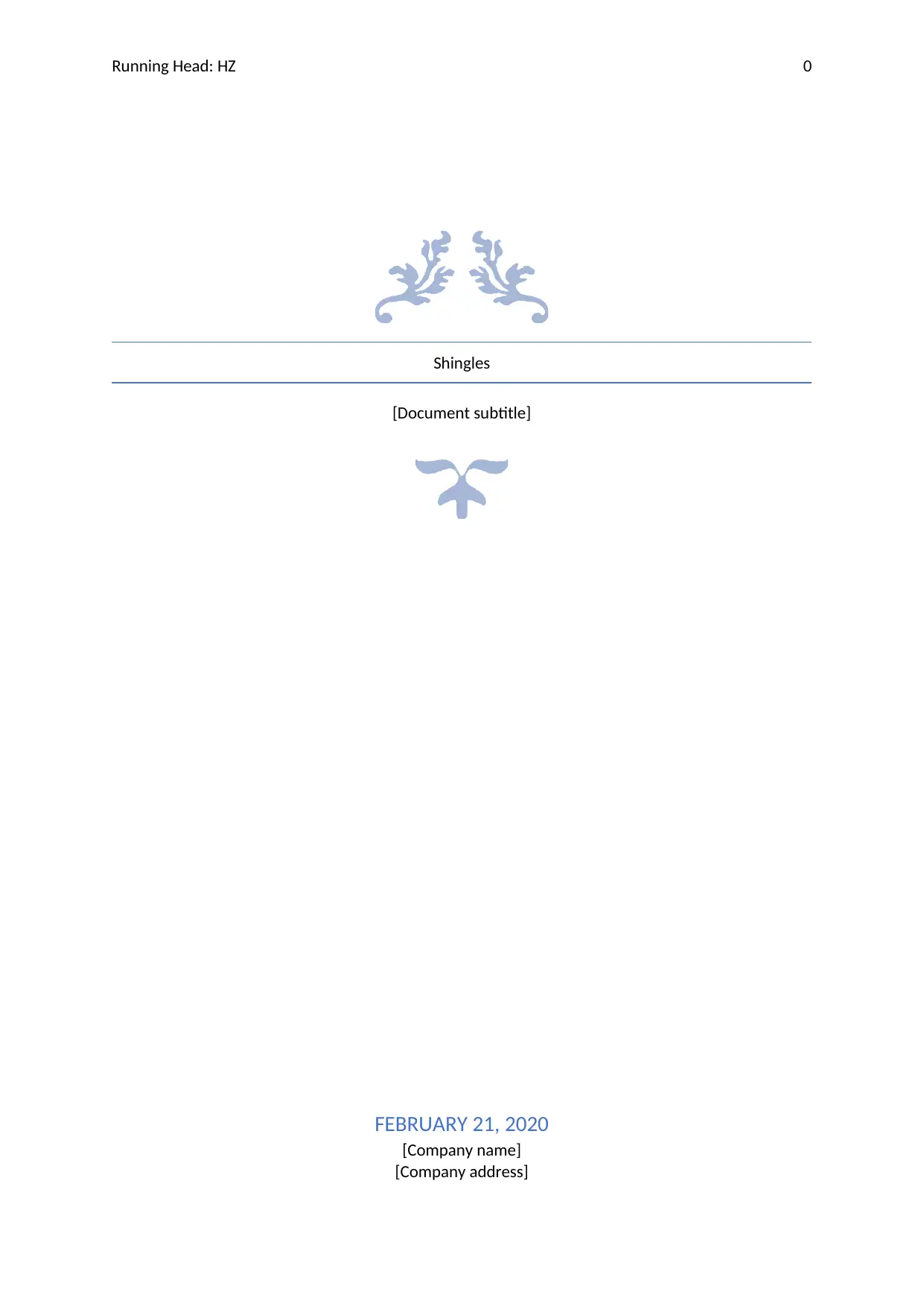
Running Head: HZ 0
Shingles
[Document subtitle]
FEBRUARY 21, 2020
[Company name]
[Company address]
Shingles
[Document subtitle]
FEBRUARY 21, 2020
[Company name]
[Company address]
Paraphrase This Document
Need a fresh take? Get an instant paraphrase of this document with our AI Paraphraser
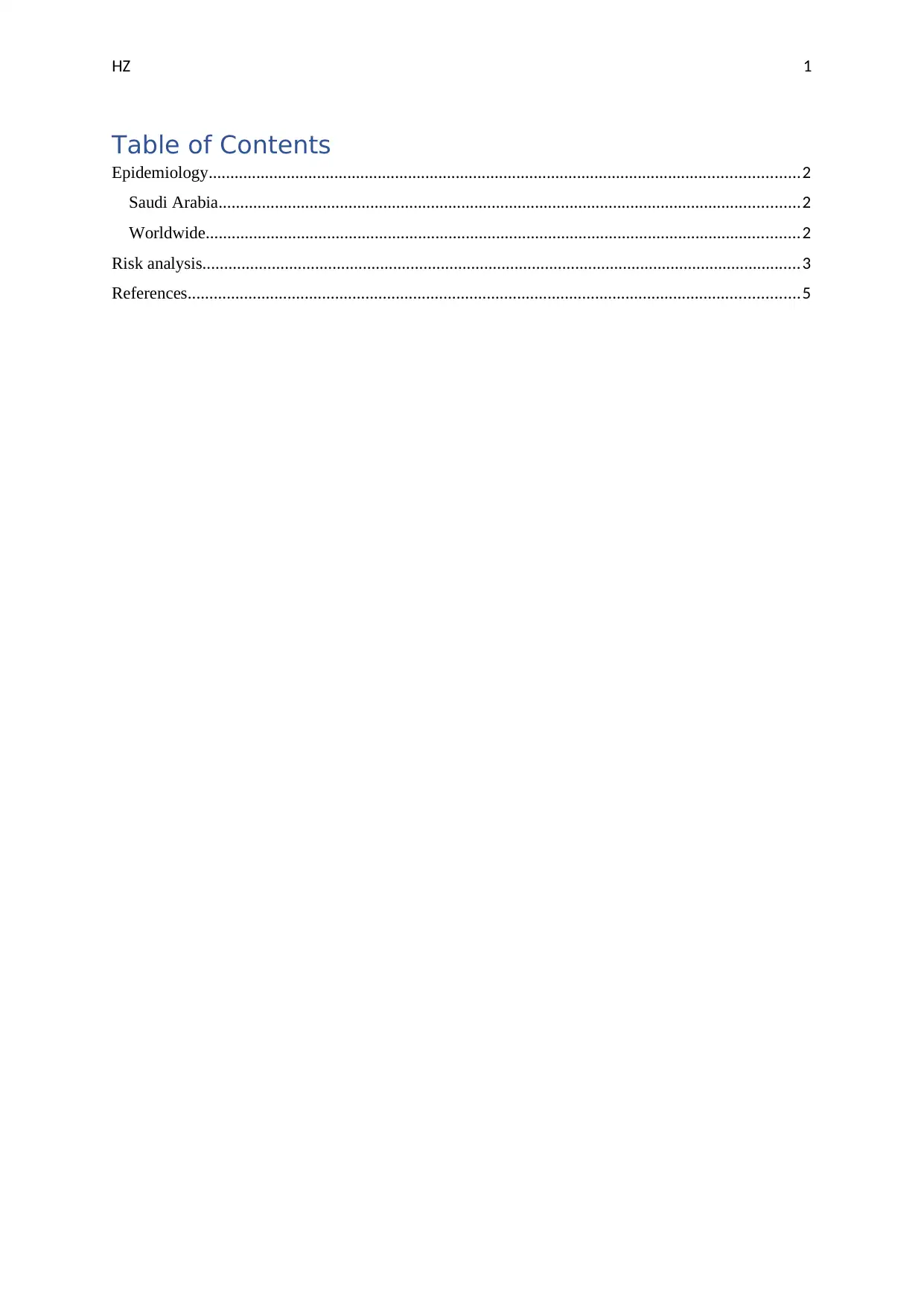
HZ 1
Table of Contents
Epidemiology........................................................................................................................................2
Saudi Arabia......................................................................................................................................2
Worldwide.........................................................................................................................................2
Risk analysis..........................................................................................................................................3
References.............................................................................................................................................5
Table of Contents
Epidemiology........................................................................................................................................2
Saudi Arabia......................................................................................................................................2
Worldwide.........................................................................................................................................2
Risk analysis..........................................................................................................................................3
References.............................................................................................................................................5
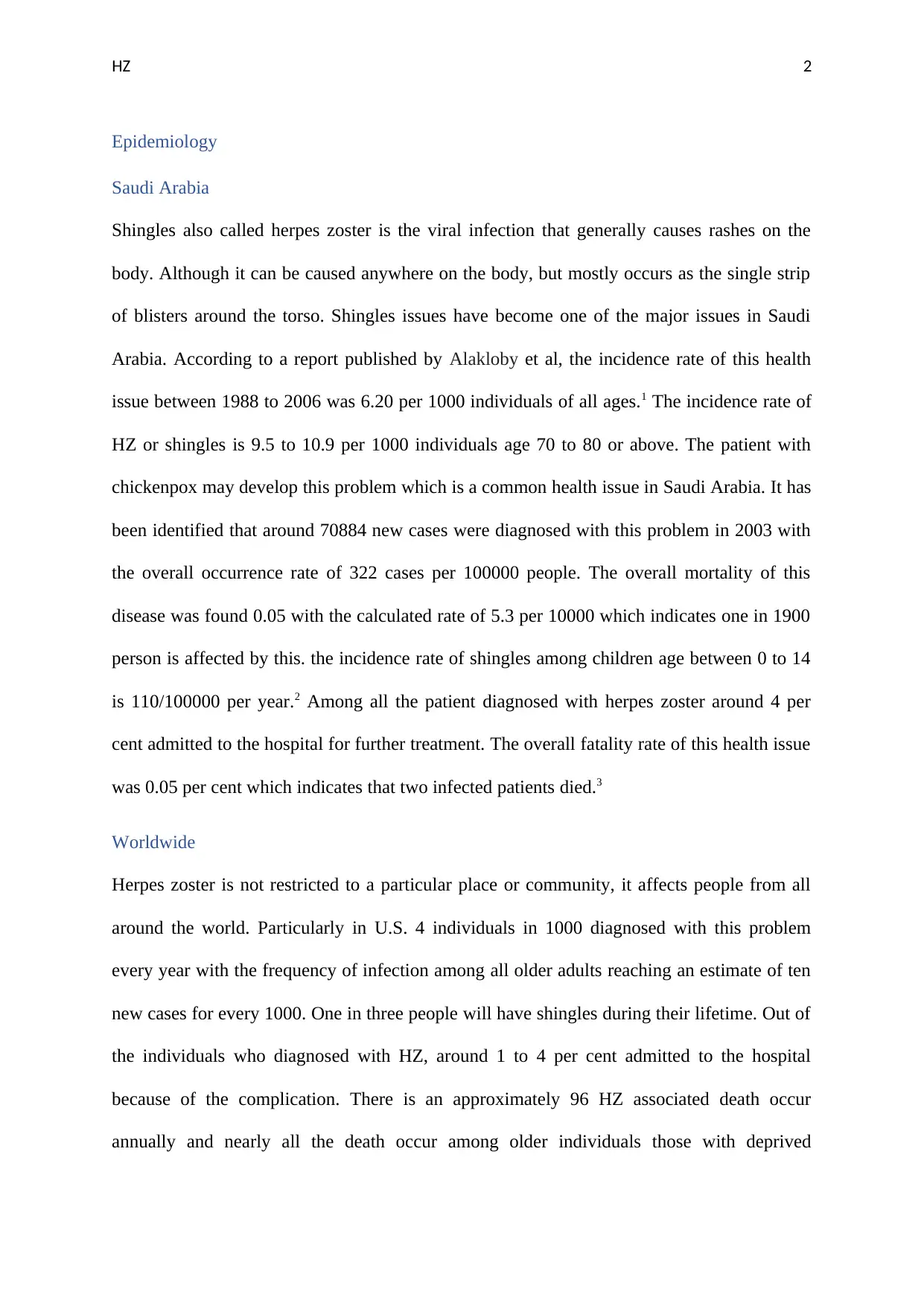
HZ 2
Epidemiology
Saudi Arabia
Shingles also called herpes zoster is the viral infection that generally causes rashes on the
body. Although it can be caused anywhere on the body, but mostly occurs as the single strip
of blisters around the torso. Shingles issues have become one of the major issues in Saudi
Arabia. According to a report published by Alakloby et al, the incidence rate of this health
issue between 1988 to 2006 was 6.20 per 1000 individuals of all ages.1 The incidence rate of
HZ or shingles is 9.5 to 10.9 per 1000 individuals age 70 to 80 or above. The patient with
chickenpox may develop this problem which is a common health issue in Saudi Arabia. It has
been identified that around 70884 new cases were diagnosed with this problem in 2003 with
the overall occurrence rate of 322 cases per 100000 people. The overall mortality of this
disease was found 0.05 with the calculated rate of 5.3 per 10000 which indicates one in 1900
person is affected by this. the incidence rate of shingles among children age between 0 to 14
is 110/100000 per year.2 Among all the patient diagnosed with herpes zoster around 4 per
cent admitted to the hospital for further treatment. The overall fatality rate of this health issue
was 0.05 per cent which indicates that two infected patients died.3
Worldwide
Herpes zoster is not restricted to a particular place or community, it affects people from all
around the world. Particularly in U.S. 4 individuals in 1000 diagnosed with this problem
every year with the frequency of infection among all older adults reaching an estimate of ten
new cases for every 1000. One in three people will have shingles during their lifetime. Out of
the individuals who diagnosed with HZ, around 1 to 4 per cent admitted to the hospital
because of the complication. There is an approximately 96 HZ associated death occur
annually and nearly all the death occur among older individuals those with deprived
Epidemiology
Saudi Arabia
Shingles also called herpes zoster is the viral infection that generally causes rashes on the
body. Although it can be caused anywhere on the body, but mostly occurs as the single strip
of blisters around the torso. Shingles issues have become one of the major issues in Saudi
Arabia. According to a report published by Alakloby et al, the incidence rate of this health
issue between 1988 to 2006 was 6.20 per 1000 individuals of all ages.1 The incidence rate of
HZ or shingles is 9.5 to 10.9 per 1000 individuals age 70 to 80 or above. The patient with
chickenpox may develop this problem which is a common health issue in Saudi Arabia. It has
been identified that around 70884 new cases were diagnosed with this problem in 2003 with
the overall occurrence rate of 322 cases per 100000 people. The overall mortality of this
disease was found 0.05 with the calculated rate of 5.3 per 10000 which indicates one in 1900
person is affected by this. the incidence rate of shingles among children age between 0 to 14
is 110/100000 per year.2 Among all the patient diagnosed with herpes zoster around 4 per
cent admitted to the hospital for further treatment. The overall fatality rate of this health issue
was 0.05 per cent which indicates that two infected patients died.3
Worldwide
Herpes zoster is not restricted to a particular place or community, it affects people from all
around the world. Particularly in U.S. 4 individuals in 1000 diagnosed with this problem
every year with the frequency of infection among all older adults reaching an estimate of ten
new cases for every 1000. One in three people will have shingles during their lifetime. Out of
the individuals who diagnosed with HZ, around 1 to 4 per cent admitted to the hospital
because of the complication. There is an approximately 96 HZ associated death occur
annually and nearly all the death occur among older individuals those with deprived
⊘ This is a preview!⊘
Do you want full access?
Subscribe today to unlock all pages.

Trusted by 1+ million students worldwide
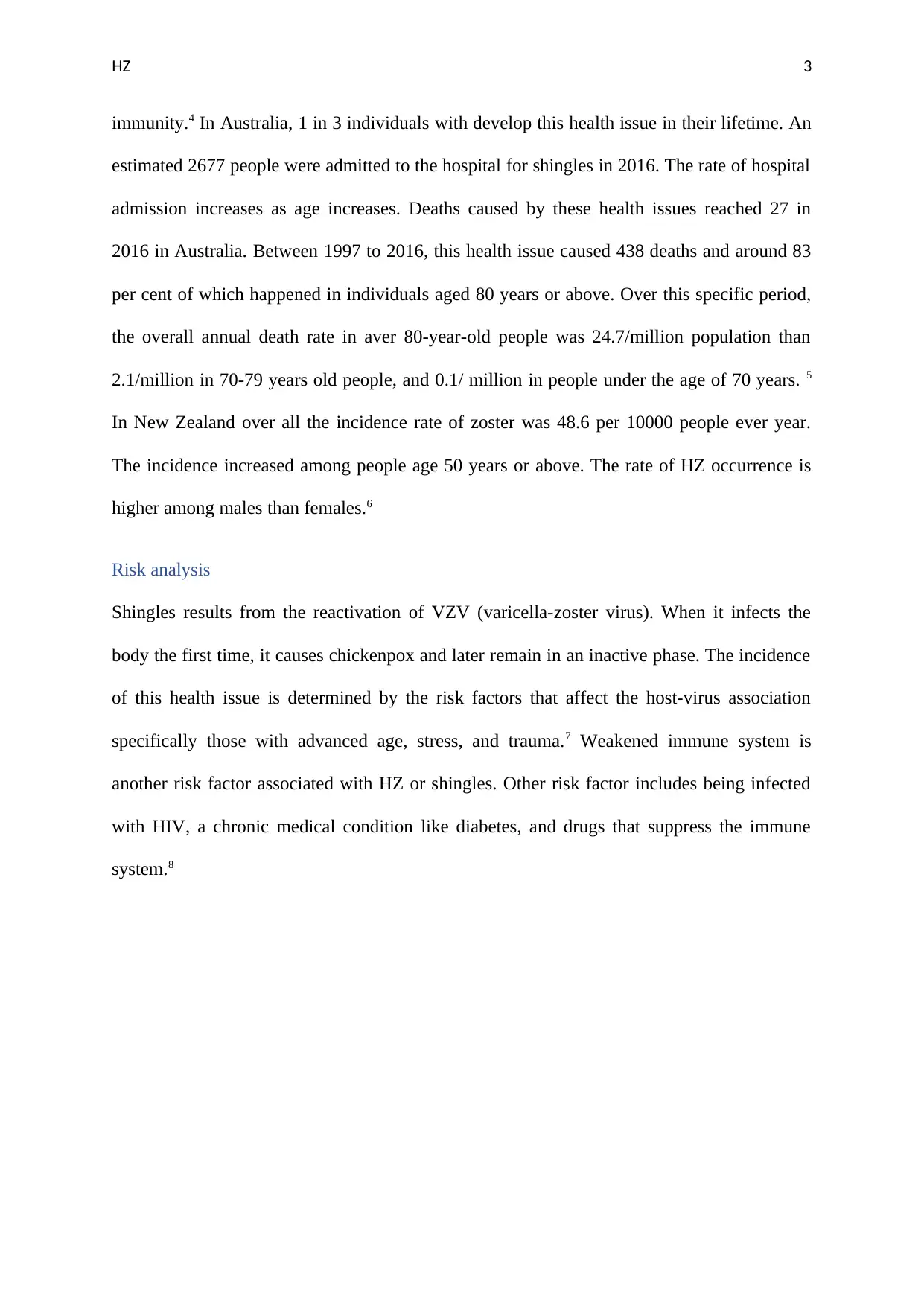
HZ 3
immunity.4 In Australia, 1 in 3 individuals with develop this health issue in their lifetime. An
estimated 2677 people were admitted to the hospital for shingles in 2016. The rate of hospital
admission increases as age increases. Deaths caused by these health issues reached 27 in
2016 in Australia. Between 1997 to 2016, this health issue caused 438 deaths and around 83
per cent of which happened in individuals aged 80 years or above. Over this specific period,
the overall annual death rate in aver 80-year-old people was 24.7/million population than
2.1/million in 70-79 years old people, and 0.1/ million in people under the age of 70 years. 5
In New Zealand over all the incidence rate of zoster was 48.6 per 10000 people ever year.
The incidence increased among people age 50 years or above. The rate of HZ occurrence is
higher among males than females.6
Risk analysis
Shingles results from the reactivation of VZV (varicella-zoster virus). When it infects the
body the first time, it causes chickenpox and later remain in an inactive phase. The incidence
of this health issue is determined by the risk factors that affect the host-virus association
specifically those with advanced age, stress, and trauma.7 Weakened immune system is
another risk factor associated with HZ or shingles. Other risk factor includes being infected
with HIV, a chronic medical condition like diabetes, and drugs that suppress the immune
system.8
immunity.4 In Australia, 1 in 3 individuals with develop this health issue in their lifetime. An
estimated 2677 people were admitted to the hospital for shingles in 2016. The rate of hospital
admission increases as age increases. Deaths caused by these health issues reached 27 in
2016 in Australia. Between 1997 to 2016, this health issue caused 438 deaths and around 83
per cent of which happened in individuals aged 80 years or above. Over this specific period,
the overall annual death rate in aver 80-year-old people was 24.7/million population than
2.1/million in 70-79 years old people, and 0.1/ million in people under the age of 70 years. 5
In New Zealand over all the incidence rate of zoster was 48.6 per 10000 people ever year.
The incidence increased among people age 50 years or above. The rate of HZ occurrence is
higher among males than females.6
Risk analysis
Shingles results from the reactivation of VZV (varicella-zoster virus). When it infects the
body the first time, it causes chickenpox and later remain in an inactive phase. The incidence
of this health issue is determined by the risk factors that affect the host-virus association
specifically those with advanced age, stress, and trauma.7 Weakened immune system is
another risk factor associated with HZ or shingles. Other risk factor includes being infected
with HIV, a chronic medical condition like diabetes, and drugs that suppress the immune
system.8
Paraphrase This Document
Need a fresh take? Get an instant paraphrase of this document with our AI Paraphraser
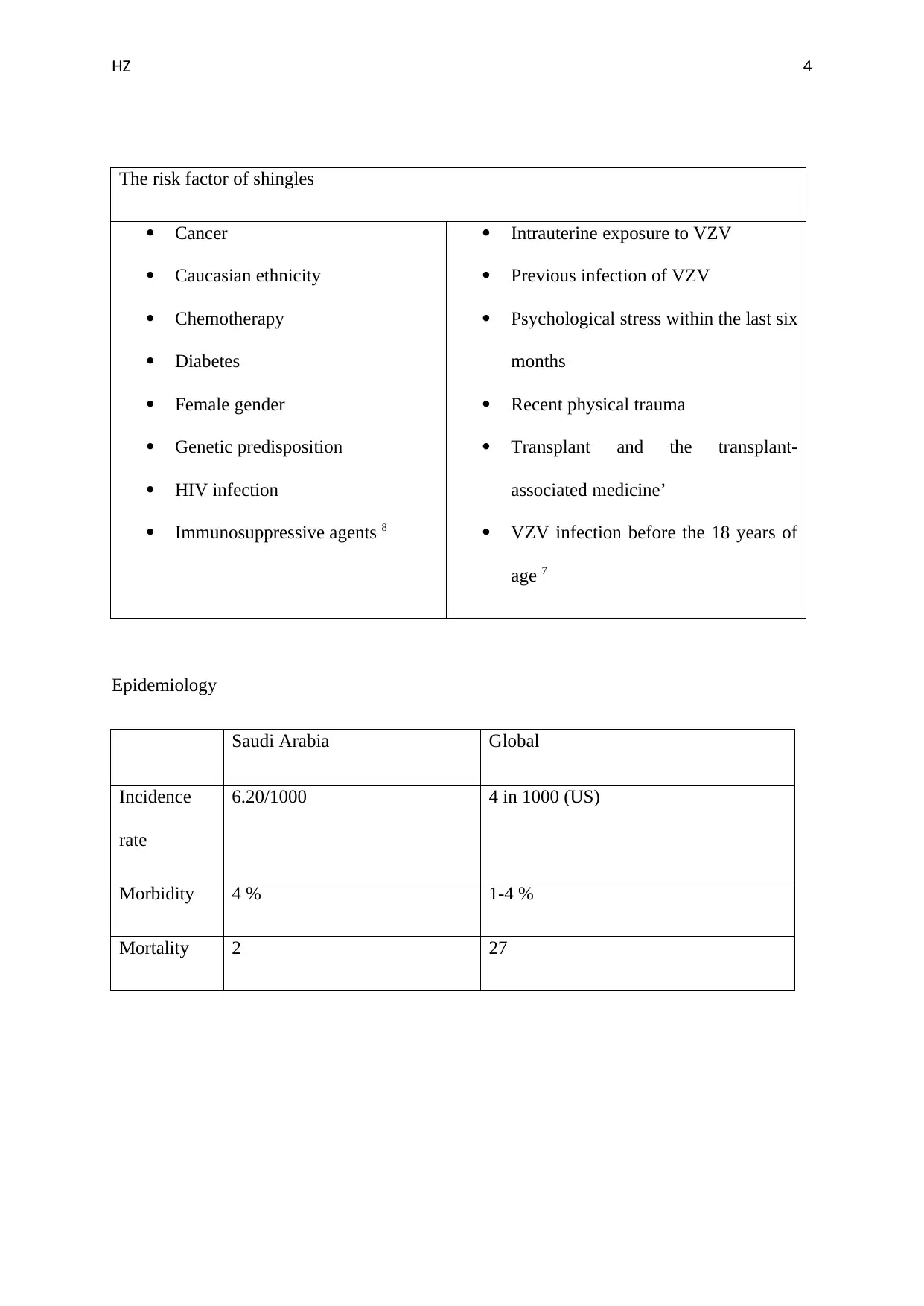
HZ 4
The risk factor of shingles
Cancer
Caucasian ethnicity
Chemotherapy
Diabetes
Female gender
Genetic predisposition
HIV infection
Immunosuppressive agents 8
Intrauterine exposure to VZV
Previous infection of VZV
Psychological stress within the last six
months
Recent physical trauma
Transplant and the transplant-
associated medicine’
VZV infection before the 18 years of
age 7
Epidemiology
Saudi Arabia Global
Incidence
rate
6.20/1000 4 in 1000 (US)
Morbidity 4 % 1-4 %
Mortality 2 27
The risk factor of shingles
Cancer
Caucasian ethnicity
Chemotherapy
Diabetes
Female gender
Genetic predisposition
HIV infection
Immunosuppressive agents 8
Intrauterine exposure to VZV
Previous infection of VZV
Psychological stress within the last six
months
Recent physical trauma
Transplant and the transplant-
associated medicine’
VZV infection before the 18 years of
age 7
Epidemiology
Saudi Arabia Global
Incidence
rate
6.20/1000 4 in 1000 (US)
Morbidity 4 % 1-4 %
Mortality 2 27
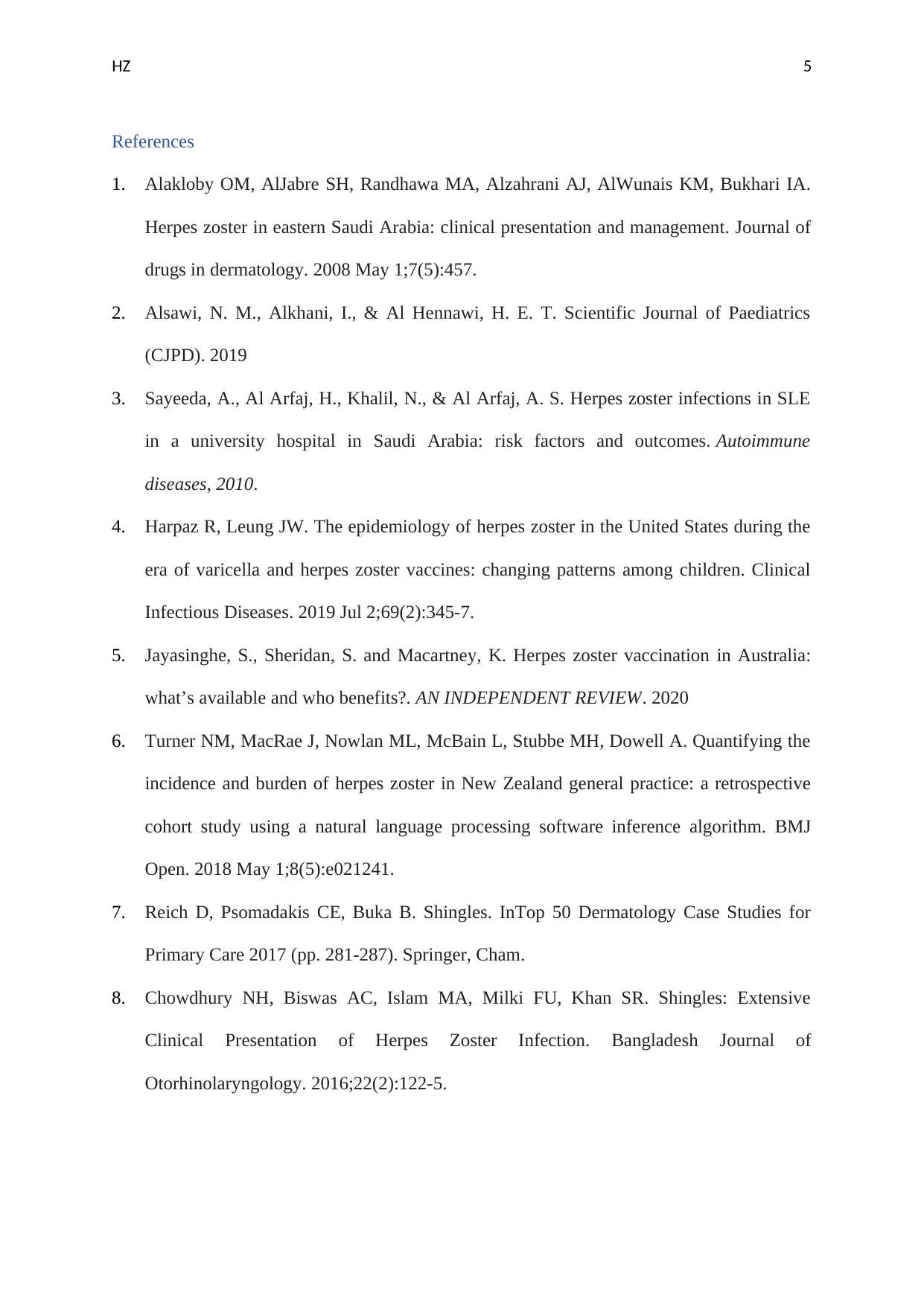
HZ 5
References
1. Alakloby OM, AlJabre SH, Randhawa MA, Alzahrani AJ, AlWunais KM, Bukhari IA.
Herpes zoster in eastern Saudi Arabia: clinical presentation and management. Journal of
drugs in dermatology. 2008 May 1;7(5):457.
2. Alsawi, N. M., Alkhani, I., & Al Hennawi, H. E. T. Scientific Journal of Paediatrics
(CJPD). 2019
3. Sayeeda, A., Al Arfaj, H., Khalil, N., & Al Arfaj, A. S. Herpes zoster infections in SLE
in a university hospital in Saudi Arabia: risk factors and outcomes. Autoimmune
diseases, 2010.
4. Harpaz R, Leung JW. The epidemiology of herpes zoster in the United States during the
era of varicella and herpes zoster vaccines: changing patterns among children. Clinical
Infectious Diseases. 2019 Jul 2;69(2):345-7.
5. Jayasinghe, S., Sheridan, S. and Macartney, K. Herpes zoster vaccination in Australia:
what’s available and who benefits?. AN INDEPENDENT REVIEW. 2020
6. Turner NM, MacRae J, Nowlan ML, McBain L, Stubbe MH, Dowell A. Quantifying the
incidence and burden of herpes zoster in New Zealand general practice: a retrospective
cohort study using a natural language processing software inference algorithm. BMJ
Open. 2018 May 1;8(5):e021241.
7. Reich D, Psomadakis CE, Buka B. Shingles. InTop 50 Dermatology Case Studies for
Primary Care 2017 (pp. 281-287). Springer, Cham.
8. Chowdhury NH, Biswas AC, Islam MA, Milki FU, Khan SR. Shingles: Extensive
Clinical Presentation of Herpes Zoster Infection. Bangladesh Journal of
Otorhinolaryngology. 2016;22(2):122-5.
References
1. Alakloby OM, AlJabre SH, Randhawa MA, Alzahrani AJ, AlWunais KM, Bukhari IA.
Herpes zoster in eastern Saudi Arabia: clinical presentation and management. Journal of
drugs in dermatology. 2008 May 1;7(5):457.
2. Alsawi, N. M., Alkhani, I., & Al Hennawi, H. E. T. Scientific Journal of Paediatrics
(CJPD). 2019
3. Sayeeda, A., Al Arfaj, H., Khalil, N., & Al Arfaj, A. S. Herpes zoster infections in SLE
in a university hospital in Saudi Arabia: risk factors and outcomes. Autoimmune
diseases, 2010.
4. Harpaz R, Leung JW. The epidemiology of herpes zoster in the United States during the
era of varicella and herpes zoster vaccines: changing patterns among children. Clinical
Infectious Diseases. 2019 Jul 2;69(2):345-7.
5. Jayasinghe, S., Sheridan, S. and Macartney, K. Herpes zoster vaccination in Australia:
what’s available and who benefits?. AN INDEPENDENT REVIEW. 2020
6. Turner NM, MacRae J, Nowlan ML, McBain L, Stubbe MH, Dowell A. Quantifying the
incidence and burden of herpes zoster in New Zealand general practice: a retrospective
cohort study using a natural language processing software inference algorithm. BMJ
Open. 2018 May 1;8(5):e021241.
7. Reich D, Psomadakis CE, Buka B. Shingles. InTop 50 Dermatology Case Studies for
Primary Care 2017 (pp. 281-287). Springer, Cham.
8. Chowdhury NH, Biswas AC, Islam MA, Milki FU, Khan SR. Shingles: Extensive
Clinical Presentation of Herpes Zoster Infection. Bangladesh Journal of
Otorhinolaryngology. 2016;22(2):122-5.
⊘ This is a preview!⊘
Do you want full access?
Subscribe today to unlock all pages.

Trusted by 1+ million students worldwide
1 out of 6
Related Documents
Your All-in-One AI-Powered Toolkit for Academic Success.
+13062052269
info@desklib.com
Available 24*7 on WhatsApp / Email
![[object Object]](/_next/static/media/star-bottom.7253800d.svg)
Unlock your academic potential
Copyright © 2020–2025 A2Z Services. All Rights Reserved. Developed and managed by ZUCOL.




